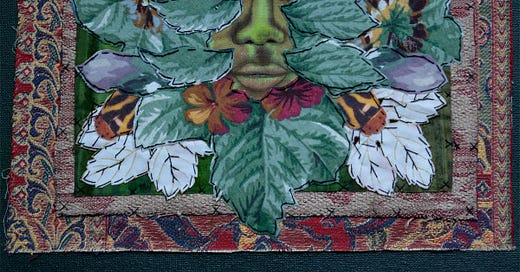In the May chapter of my book, Seasons of a Wild Life, I introduce the Green Man.
On European Medieval structures, he is often depicted as a horned woodland character with leaves and vines growing out of his mouth and ears. Neo-Pagans and Wiccans consider the Green Man a version of the Horned God who in turn may be a derivation of several earlier nature and fertility deities such as the Greek Pan and Dionysus or the Roman Faunus, a forest spirit who symbolized unconstrained male vitality and the universal generative force. Faunus has been portrayed as a human male with horns or as a human-goat hybrid creature.
I have been intrigued by the Green Man wondering about his ancient origin and found him popping up in many places around the world. Over 5,000 years ago, the ancient Sumerians spoke of Humbaba, the guardian of the cedar forest and Enkidu, a wild forest man. Pashupati, the horned Lord of the Beasts, first appeared around 3,000 BCE in India. Sitting cross-legged in a yogic posture, surrounded by animals, he is worshiped as an incarnation of the Hindu god Shiva. Ancient Egyptians, Phrygians, Tibetans and Aztecs all honored a similar male deity.
(A modern interpretation of the Green Man by Hope Davis Wood, an artist in Virginia)
Islamic Sufism refers to a man called Al-Khidr (“The Green One” or “The Verdant One”) who appeared spontaneously and imparted wisdom and mystical knowledge. Al-Khidr came in many impersonations throughout history. One story tells of Alexander the Great and his servant Khadir who searched for the Well of Life with its power of immortality. As they entered a cave in the mountains of the Sahara desert, Khadir fell into the well at the bottom of the cave thus gaining immortality. Alexander died at the age of 33.
In Caribbean folklore, Papa Bois is known as the protector of the animals and the forest. He is either pictured as a physically powerful old man or as a mythical creature with cloven hoofs and horns. Papa Bois, a major deity in the Voodoo religion, commands great powers of healing and possesses the secrets of life and death.
In Ecuador, Sacha Runa (“forest being”) has become a symbol for the preservation of the Amazon rainforest. Sacha Runa protects animals and instructs shamans in their plant work. Together with Sacha Huarmi, Green Woman or Jungle woman, they act as intermediaries between humans and plant spirits.
Given that the Green Man has appeared in so many different locations, time periods, and cultures, I choose to think of him as a part of our collective unconscious, a primal male archetype reflecting our relationship with and place in Nature.





Interesting! Things I hadn’t know about the Green Man.